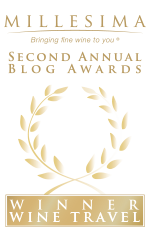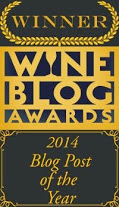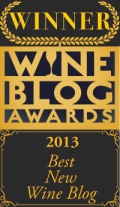After departing Pinot-centric Central Otago, I carried on north to the next New Zealand wine region of Canterbury, located about 45 minutes outside of Christchurch. One of my three winemaker visits included the eye-opening Pyramid Valley, known for being the first vineyard in New Zealand — and one of only a few in the world — to be established from nascency under strict biodynamic principles, as well as stick to a strong non-interventionist/natural winemaking philosophy.
My lovely host for the afternoon, Brittany Thompson, Assistant Winemaker and Production Manager, picked me up in her truck full of energetic dogs. Our visit started not with a traditional winery tasting, but rather a picnic on top of a nearby hill with wine box “baskets” prepared by winery co-owner Claudia Weersing, who dabbles, quite effectively, in cooking. Apparently, I was the guinea pig for the wine box-cum-picnic basket concept, and I wholeheartedly gave it a green light, suggesting they make it available to future customers. The box included a clever dessert in a jar, smartly wrapped sandwiches, and the elusive greengage plum–my first. I was also introduced to the country fun of sliding down a hillside hay field on one’s belly or back, an activity apparently never endeavored with journalists — until meeting me.
Set in Northern Canterbury, Pyramid Valley Vineyards, was founded in 2000 by Mike and Claudia Weersing. They spent ten years working to find the perfect tract of land with the ideal limestone and geology make-up for the vines they wished to plant. They knew they’d hit proverbial paydirt when the consultant back in France reviewing their soil sample asked where they were in Burgundy. After pulling the hay from my hair and out of my shirt, and socks, and pants, we sat down at the tasting bar to go through their entire line-up of wines. I had a hard time holding back my surprise at how characterful, how evocative of place each wine was. Certainly no poker face could I project. I was particularly fond of the Cab Franc — it was the best I tasted in all of New Zealand. I recommend tracking down their Pinots, Chardonnays–frankly, anything from this winery.
THE OWNERS MIKE AND CLAUDIA:
Mike and Claudia Weersing came to New Zealand in 1996, when Mike began making wine with Tim and Judy Finn at Neudorf Vineyards in Nelson. After a long and intensive search to find a site for their own vineyard, they purchased a farm in the Pyramid Valley, near Waikari in North Canterbury, in 2000.
Mike studied oenology and viticulture in Burgundy, beginning at the Lycee Viticole in Beaune, and continuing at the Universite de Bourgogne in Dijon. He has worked extensively in the vineyards and cellars of Europe, for producers such as Hubert de Montille, Domaine de la Pousse d’Or, and Nicolas Potel in Burgundy; Jean-Michel Deiss and Marc Kreydenweiss in Alsace; and Ernst Loosen in the Mosel. He has made wine in France and in Spain for Randall Grahm of Bonny DoonVineyards, vinifying in the Rhone Valley, the Languedoc-Roussillon, and the Navarra. New world vintages include apprenticeships with James Halliday at Coldstream Hills in the Yarra Valley of Australia, and with Russ Raney at Evesham Wood in Oregon’s Eola Hills.
Claudia was born in Schleswig, Germany. A fashion student and skilled clothesmaker by trade, she is now a committed biodynamicist which guides her approach to the land.
Wine to us is a genie, genius loci; our job is to coax it from its rock to bottle. Every gesture we make, in vineyard and winery, is a summons to this spirit of place. Biodynamics, hand-based viticulture, low yields, natural winemaking – these are some of the means we’ve adopted better to record and transmit this voice.
For example, all of our wines are fermented with their own yeast starters, cultured every year, from the vineyard itself. If wine is meant to be the bottled breath of a certain place, from a certain moment in time, then we feel that working with yeasts from that site, of that season, is an important step towards transparency and authenticity. Our cultures allow very long, very regular ferments: most of our whites ferment for more than a year. During this time, the wine is protected, so no sulphur is necessary. After so long a ferment, the wine is stable: thus most of our wines are bottled unfiltered, again with little or no sulphur.
Each wine is allowed to flower as it wishes. If the Pinot Blanc stops with 4 grams RS, so be it. If the Gewurztraminer ferments to dryness, that is its choice. As my friend and hero Edmond Vatan once replied when I asked him about malolactic fermentation, “Pwah, le malo, si ca se fait, ca se fait.”
So, at home we’ve sponsored a marriage of clay-limestone soils to Pinot Noir and Chardonnay, hoping to bring to the wine world a special, new place-voice. With the Growers Collection, we are allowed to work with admired colleagues, and with sites, soils, varieties different than those at home. All of our wines are devoted to people and place; all bring rich rewards of community.
Each block is planted to reflect a specific soil type hence the somewhat irregular looking blocks. In total we have only 2.2 hectares planted in 4 separate blocks. The differences you can taste reflects the soil and climatic differences between each block, which is never more than 400 metres at most. We vinify each block and variety separately but identically in a mixture of old oak and clay amphorae so the outside influences on the grape are minimised.
The blocks themselves were named by Claudia after the weed varieties predominant in each, which also reflect the different soil. The Angel Flower is a more exposed block, north facing that reflects a lightness, delicacy and an ethereal scent. The Lions Tooth with its golden dandelions and obvious lime rich soil shows a rich golden colour with a toasty sulphite nose. The Earth Smoke is a heavier clay, with a denser, wild, gamey outcome. The Field of Fire slopes away to an eastern aspect and into the heaviest clay and makes typically a green-hued delicate wine.





















